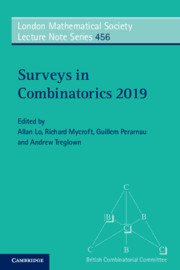Book contents
- Frontmatter
- Preface
- Contents
- 1 Clique-width for hereditary graph classes
- 2 Analytic representations of large graphs
- 3 Topological connectedness and independent sets in graphs
- 4 Expanders – how to find them, and what to find in them
- 5 Supersingular isogeny graphs in cryptography
- 6 Delta-matroids for graph theorists
- 7 Extremal theory of vertex or edge ordered graphs
- 8 Some combinatorial and geometric constructions of spherical buildings
5 - Supersingular isogeny graphs in cryptography
Published online by Cambridge University Press: 17 June 2019
- Frontmatter
- Preface
- Contents
- 1 Clique-width for hereditary graph classes
- 2 Analytic representations of large graphs
- 3 Topological connectedness and independent sets in graphs
- 4 Expanders – how to find them, and what to find in them
- 5 Supersingular isogeny graphs in cryptography
- 6 Delta-matroids for graph theorists
- 7 Extremal theory of vertex or edge ordered graphs
- 8 Some combinatorial and geometric constructions of spherical buildings
Summary
We describe recent applications of expander graphs in cryptography, particularly supersingular isogeny graphs. The security of these cryptographic constructions relies on the assumption that computing paths in these graphs is practically infeasible, even with a quantum computer. One of these cryptographic constructions is currently considered for standardization by NIST. We also recall a related construction based on Lubotzky-Philips-Sarnak's celebrated Ramanujan graphs. We describe an efficient path-finding algorithm for these graphs which was motivated by the cryptographic application, and we mention connections to the problem of optimal quantum circuit synthesis.
Information
- Type
- Chapter
- Information
- Surveys in Combinatorics 2019 , pp. 143 - 166Publisher: Cambridge University PressPrint publication year: 2019
Accessibility standard: Unknown
Why this information is here
This section outlines the accessibility features of this content - including support for screen readers, full keyboard navigation and high-contrast display options. This may not be relevant for you.Accessibility Information
- 1
- Cited by
